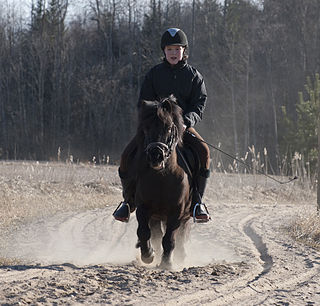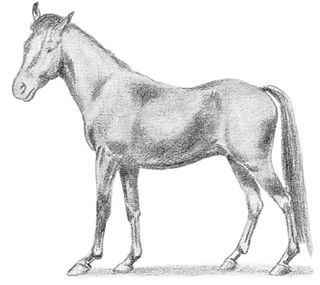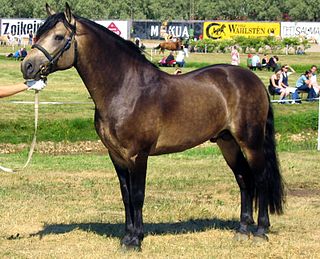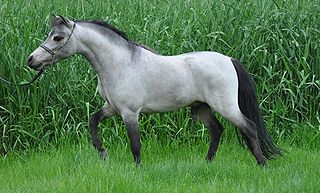Related Research Articles

The horse is a domesticated, one-toed, hoofed mammal. It belongs to the taxonomic family Equidae and is one of two extant subspecies of Equus ferus. The horse has evolved over the past 45 to 55 million years from a small multi-toed creature, close to Eohippus, into the large, single-toed animal of today. Humans began domesticating horses around 4000 BCE, and their domestication is believed to have been widespread by 3000 BCE. Horses in the subspecies caballus are domesticated, although some domesticated populations live in the wild as feral horses. These feral populations are not true wild horses, which are horses that never have been domesticated and historically linked to the megafauna category of species. There is an extensive, specialized vocabulary used to describe equine-related concepts, covering everything from anatomy to life stages, size, colors, markings, breeds, locomotion, and behavior.

The Shetland pony is a Scottish breed of pony originating in the Shetland Islands in the north of Scotland. It may stand up to 107 cm (42 in) at the withers. It has a heavy coat and short legs, is strong for its size, and is used for riding, driving, and pack purposes.

The Konik or Polish Konik is a Polish breed of pony. There are semi-feral populations in some regions. They are usually mouse dun or striped dun in color.

The Exmoor Pony is a British breed of pony or small horse. It is one of the mountain and moorland pony breeds native to the British Isles, and so falls within the larger Celtic group of European ponies. It originates on, and is named for, the Exmoor area of moorland in north-eastern Devon and western Somerset, in south-west England, and is well adapted to the climate conditions and poor grazing of the moor. Some still live there in a near-feral state, but most are in private ownership.

The Falabella is an Argentine breed of small horse. It is among the smallest of horse breeds, with a height at the withers in the range 63–86 cm (25–34 in)..

The Lundy Pony is a British breed of pony bred on Lundy Island in the twentieth century.

The Manipuri Pony is a traditional Indian breed of small horse or pony from Assam and Manipur in north-eastern India. It appears both in the history and the mythology of Manipur, and was used for warfare and polo. It is believed to have been the polo pony in use in Assam in the mid-nineteenth century when British tea planters first saw polo being played, and the height limits set for polo ponies were based on ponies of this breed. It was very numerous in the early twentieth century, but numbers have since fallen. A breed society was established in 1977, and a breed standard was drawn up by the Indigenous Horse Society of India in 2009.

The Gotland Russ or Gotland Pony is an old Swedish breed of pony or small horse. Until the twentieth century it was found only on the small island of Gotland on the south-eastern coast of Sweden. It is now distributed through much of Sweden and is also present in some other European countries and in the United States. The Öland horse from the neighbouring island of Öland was a close relative of the Gotland, but became extinct in the early twentieth century.
The American Walking Pony is a modern American breed of gaited riding pony. It was created by crossbreeding of the Tennessee Walking Horse and the Welsh Pony. Originally developed in Georgia, the breed was established in 1968 after several years of selective breeding. Joan Hudson Brown is credited as the founder of the breed and was the first executive secretary of the breed registry. The original breeding goal was to combine the smooth gait of the Tennessee Walker with the small size and refinement of the Welsh pony. Any combination of the two breeds is acceptable for the registry.

The Landais is a critically-endangered French breed of small horse or pony. It originated in the marshy plains and woodlands of the département of the Landes, in the Nouvelle-Aquitaine region of south-western France, but is more often reared in the département of Pyrénées-Atlantiques, particularly in the arrondissement of Pau. Due to influences from Arab and Welsh blood, it shows more similarity to Oriental horses than to other Celtic breeds. It is used for riding and driving, and is a good trotter.

The Irish Hobby is an extinct breed of horse developed in Ireland prior to the 13th century. The breed provided foundation bloodlines for several modern horse breeds, including breeds as diverse as the Connemara pony and the Irish Draught. Palfreys were known as haubini in France, which eventually became hobbeye. These animals eventually found their way to Ireland where the Irish Hobby developed.

The British Spotted Pony is a British breed of pony characterised by a spotted coat. The height at the withers does not exceed 147 cm.

The Estonian Native,, is an Estonian breed of small horse. It is strong and is resistant to disease. It is one of three recognised horse breeds in Estonia, the others being the Tori and the Estonian Draft, both of which derive from it. It has also influenced other Northern European breeds such as the Latvian Warmblood, and the Vyatka and the extinct Obva in Russia. It is an endangered breed; the population fell from about 16000 in the 1950s to approximately 500 in 2004.

The Bhimthadi or Deccani horse is an almost extinct breed of Indian horses. It was developed in Pune district in 17th and 18th centuries during the Maratha rule by crossing Arabian and Turkic breeds with local horse breed.

The Lac La Croix Indian Pony (LLCIP), also known as the Ojibwe pony is a semi-feral Canadian horse breed developed by the Ojibwe people. The population became critically low; and, by 1977, only four mares remained. To preserve the breed, these mares were crossed with Spanish Mustang stallions. The modern breed name derives from the Lac La Croix First Nation of Ontario, where the horses were last found in the wild. Historically, the breed was also found in Minnesota.
The Baixedeiro is a small-sized horse breed that originated in the marshy regions of Brazil. Most of them are close to extinct and are currently under conservation in Brazil. They have a similar look to the Pantaneiro horse breed of Brazil but are smaller in size than this breed. They do best in wetlands most of the year, which is part of why they are undeveloped.

The American Miniature Horse is an American breed of small or miniature horse. It has been selectively bred to display in miniature the physical characteristics of a full-sized horse, and usually stands no taller than about 38 in (97 cm). It frequently has the appearance of either a small Arab or a small draft horse; genetically it is no different to pony breeds such as the Shetland.
The Bhirum Pony or Nigerian Pony is a Nigerian breed of pony or small horse. It developed in Nigeria’s northern regions.

The Karelian is a pony native to Karelia, a region of northern Europe between the Gulf of Finland and the White Sea. Approximately 1.40 m tall, with a large head and angular physique, this pony belongs to the North Russian equine group. Reputedly very hardy, it sometimes shows primitive markings on its coat.

The Amourski, also known as Amur horse or Manchurian pony, is an extinct breed of small Siberian and Manchurian horses. Formed in the early 19th century, it originated from the area around the Amur River in northeast Asia, in Russia and China. These small horses, more refined than other Siberian breeds, were usually ridden or driven, and were known for their hardiness.
References
- ↑ "EXTINCT BREEDS LIST" (PDF). Food and Agriculture Organization of the United Nations.
- ↑ "Equus caballus (horses)". www.cabi.org. Retrieved 2020-07-20.
- 1 2 Porter, Valerie (2020-05-26). Mason's World Dictionary of Livestock Breeds, Types and Varieties, 6th Edition. CABI. p. 209. ISBN 978-1-78924-153-2.
- ↑ Rousseau, Élise (2017-05-09). Horses of the World. Princeton University Press. p. 536. ISBN 978-0-691-16720-6.